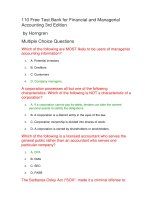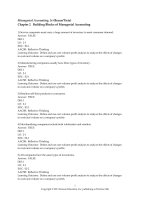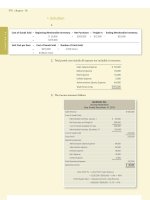Financial managerial accounting 3rd kieso ch24(standard costs and balanced scorecard)
Bạn đang xem bản rút gọn của tài liệu. Xem và tải ngay bản đầy đủ của tài liệu tại đây (256.64 KB, 71 trang )
Financial & Managerial
Accounting
3rd Edition
Weygandt Kimmel Kieso
Chapter 24
Standard Costs and
Balanced Scorecard
Prepared by
Coby Harmon
University of California, Santa Barbara
Westmont College
Chapter Outline
Learning Objectives
LO 1 Describe standard costs.
LO 2 Determine direct materials variances.
LO 3 Determine direct labor and total manufacturing
overhead variances.
LO 4 Prepare variance reports and balanced scorecards.
Copyright ©2018 John Wiley & Son, Inc.
2
Overview of Standard Costs
Advantages of Standard Costs:
1. Facilitate management planning
2. Promote greater economy by making employees more
“cost-conscious ”
3. Useful in setting selling prices
4. Contribute to management control by providing basis for
evaluation of cost control
5. Useful in highlighting variances in management by
exception
6. Simplify costing of inventories and reduce clerical costs
LO 1
Copyright ©2018 John Wiley & Son, Inc.
3
Distinguishing Between Standards and
Budgets
Both standards and budgets are predetermined costs,
and both contribute to management planning and
control.
There is a difference:
a. A standard is a unit amount
b. A budget is a total amount
LO 1
Copyright ©2018 John Wiley & Son, Inc.
4
Setting Standard Costs
Setting standard costs requires input from all persons
who have responsibility for costs and quantities.
Standards should change whenever managers
determine that the existing standard is not a good
measure of performance.
LO 1
Copyright ©2018 John Wiley & Son, Inc.
5
Setting Standard Costs
Ideal versus Normal Standards
Companies set standards at one of two levels:
• Ideal standards represent optimum levels of
performance under perfect operating conditions
• Normal standards represent efficient levels of
performance that are attainable under expected
operating conditions
LO 1
Should be rigorous but attainable
Copyright ©2018 John Wiley & Son, Inc.
6
Setting Standard Costs
Most companies that use standards set them at a(n):
a. optimum level
b. ideal level
c. normal level
d. practical level
LO 1
Copyright ©2018 John Wiley & Son, Inc.
7
Setting Standard Costs
Direct Materials
Direct materials price standard is the cost per finished unit of
direct materials that should be incurred.
Item
Purchase price, net of discounts
Freight
Receiving and handling
Standard direct materials price per pound
Price
$2.70
0.20
0.10
$3.00
ILLUSTRATION 24.2
Setting direct materials price standard
LO 1
Copyright ©2018 John Wiley & Son, Inc.
8
Setting Standard Costs
Direct Materials
ILLUSTRATION 24.3
Setting direct materials
quantity standard
Direct materials quantity standard is the quantity of direct
materials that should be used per unit of finished goods.
Item
Required materials
Allowance for waste
Allowance for spoilage
Standard direct materials quantity per unit
Quantity
(pounds)
3.5
.4
.1
4.0
Standard direct materials cost is $12.00 ($3.00 x 4.0 pounds)
LO 1
Copyright ©2018 John Wiley & Son, Inc.
9
Setting Standard Costs
The direct materials price standard should include an
amount for all of the following except:
a. receiving costs
b. storing costs
c. handling costs
d. normal spoilage costs
LO 1
Copyright ©2018 John Wiley & Son, Inc.
10
Setting Standard Costs
Direct Labor
ILLUSTRATION 24.4
Setting direct labor
price standard
Direct labor price standard is the rate per hour that should be
incurred for direct labor.
Item
Hourly wage rate
COLA
Payroll taxes
Fringe benefits
Standard direct labor price per hour
LO 1
Copyright ©2018 John Wiley & Son, Inc.
Price
$12.50
0.25
0.75
1.50
$15.00
11
Setting Standard Costs
Direct Labor
ILLUSTRATION 24.5
Setting direct labor
quantity standard
Direct labor quantity standard is the rate per hour that
should be incurred for direct labor.
Quantity
Item
(Hours)
Actual production time
1.5
Rest periods and cleanup
0.2
Setup and downtime
0.3
Standard direct labor hours per unit
2.0
Standard direct labor cost is $30.00 ($15.00 x 4.0 hours)
LO 1
Copyright ©2018 John Wiley & Son, Inc.
12
Setting Standard Costs
Manufacturing Overhead
For manufacturing overhead, companies use a standard
predetermined overhead rate in setting the standard.
Overhead rate is determined by dividing budgeted
overhead costs by an expected standard activity index,
such as standard direct labor hours or standard machine
hours.
LO 1
Copyright ©2018 John Wiley & Son, Inc.
13
Manufacturing Overhead
Xonic uses standard direct labor hours as the activity index
and expects to produce 13,200 gallons during the year at
normal capacity. It takes 2 direct labor hours for each gallon.
Budgeted
Overhead
Costs
Variable
Fixed
Total
ILLUSTRATION 24.6
Computing predetermined
overhead rates
LO 1
Amount
$79,200
52,800
$132,000
÷
Standard
Direct
Labor Hours
26,400
26,400
26,400
=
Overhead Rate
per Direct
Labor Hours
$3.00
2.00
$5.00
Standard manufacturing overhead rate per
gallon is $10 ($5 x 2 hours).
Copyright ©2018 John Wiley & Son, Inc.
14
Total Standard Cost per Unit
Xonic uses standard direct labor hours as the activity index
and expects to produce 13,200 gallons during the year at
normal capacity. It takes 2 direct labor hours for each gallon.
Product: Xonic Tonic
Manufacturing
Cost Elements
Direct materials
Direct labor
Manufacturing overhead
Total
ILLUSTRATION 24.7
Standard cost per gallon of Xonic Tonic
LO 1
Unit Measure: Gallon
Standard
Standard
Standard
Quantity x
Price
=
Cost
4 pounds
$ 3.00
$12.00
2 hours
15.00
30.00
2 hours
5.00
10.00
$52.00
The total standard cost per gallon
Copyright ©2018 John Wiley & Son, Inc.
15
DO IT! 1 Standard Costs
Ridette Inc. accumulated the following standard cost data
concerning product Cty31.
Direct materials per unit: 1.5 pounds at $4 per pound
Direct labor per unit: 0.25 hours at $13 per hour
Manufacturing overhead: rate of $15.60 per direct labor hour
Compute the standard cost of one unit of product Cty31.
Manufacturing
Cost Elements
Direct materials
Direct labor
Manufacturing overhead
Total
LO 1
Standard
Standard
Quantity x
Price
1.5 pounds
$ 4.00
0.25 hours
13.00
0.25 hours
15.60
Copyright ©2018 John Wiley & Son, Inc.
=
Standard
Cost
$6.00
3.25
3.90
$13.15
16
Direct Materials Variances
Analyzing and Reporting Variances
Variances are differences between total actual costs
and total standard costs.
Actual costs < Standard costs = Favorable variance
Actual costs > Standard costs = Unfavorable
variance
Must be analyzed to determine underlying factors.
Analyzing begins by determining the cost elements
that comprise the variance.
LO 2
Copyright ©2018 John Wiley & Son, Inc.
17
Analyzing and Reporting Variances
A variance is favorable if actual costs are:
a. less than budgeted costs.
b. less than standard costs.
c. greater than budgeted costs.
d. greater than standard costs
LO 2
Copyright ©2018 John Wiley & Son, Inc.
18
Analyzing and Reporting Variances
Illustration: Assume that
in producing 1,000
gallons of Xonic Tonic in
the month of June, Xonic
incurred the costs to the
right.
The total standard cost
of Xonic Tonic is $52,000
(1,000 gallons x $52).
Direct materials
Direct labor
Variable overhead
Fixed overhead
Total actual costs
$13,020
31,080
6,500
4,400
$55,000
ILLUSTRATION 11.8
Actual production costs
Actual costs
Less: Standard costs
Total variance
$55,000
52,000
$ 3,000
ILLUSTRATION 24.9
Computation of total variance
LO 2
Copyright ©2018 John Wiley & Son, Inc.
19
Analyzing and Reporting Variances
A variance can result from differences related to the
cost of materials, labor, or overhead.
Materials
+
Variance
Labor
Variance
Overhead
+
=
Variance
Total
Variance
ILLUSTRATION 24.10
Components of total variance
LO 2
Copyright ©2018 John Wiley & Son, Inc.
20
Analyzing and Reporting Variances
Format for computing price and quantity variances.
Total Materials or
Labor Variance
Actual Cost
Actual Quantity
x
Actual Price
Actual Quantity
x
Standard Price
Price Variance
Standard Cost
Standard Quantity
x
Standard Price
Quantity Variance
ILLUSTRATION 24.11
LO 2
Copyright ©2018 John Wiley & Son, Inc.
21
Computing Direct Materials Variances
In completing the order for 1,000 gallons of Xonic Tonic, Xonic
used 4,200 pounds of direct materials. These were purchased
at a cost of $3.10 per unit. Standard price is $3.
Actual Quantity
x Actual Price (AQ) x (AP)
$13,020
(4,200 x $3.10)
Standard Quantity
x Standard Price =
(SQ) x (SP)
$12,000
(4,000 x $3.00)
=
Total Materials
Variance
(TMV)
$1,020 U
Illustration 24.12
Formula for total materials variance
LO 2
Copyright ©2018 John Wiley & Son, Inc.
22
Computing Direct Materials Variances
Next, Xonic analyzes total variance to determine the amount
attributable to price (costs) and to quantity (use). Materials
price variance is computed from the following formula.
Actual Quantity
x Actual Price (AQ) x (AP)
Actual Quantity
x Standard Price
(AQ) x (SP)
=
Materials Price
Variance
(MPV)
$13,020
(4,200 x $3.10)
$12,600
(4,200 x $3.00)
=
$420 U
Illustration 24.14
Formula for materials price variance
LO 2
Copyright ©2018 John Wiley & Son, Inc.
23
Computing Direct Materials Variances
The materials quantity variance is determined from the
following formula.
ILLUSTRATION 24.15
Formula for materials quantity variance
Actual Quantity
x Standard Price (AQ) x (SP)
$12,060
(4,200 x $3.00)
ILLUSTRATION 24.16
Summary of materials
variance
LO 2
Standard Quantity
Materials Quantity
x Standard Price =
Variance
(SQ) x (SP)
(MQV)
$12,000
(4,000 x $3.00)
=
Materials price variance
Materials quantity variance
Total materials variance
Copyright ©2018 John Wiley & Son, Inc.
$600 U
$ 420 U
600 U
$1,020 U
24
Analyzing and Reporting Variances
1
2
Actual Quantity
× Actual Price
(AQ) × (AP)
4,200 x $3.10 = $13,020
3
Actual Quantity
× Standard Price
(AQ) × (SP)
4,200 x $3.00 = $12,600
Price Variance
1
-
Standard Quantity
× Standard Price
(SQ) × (SP)
4,000 x $3.00 = $12,000
Quantity Variance
2
2
$13,020 – $12,600 = $420 U
-
3
$12,600 – $12,000 = $600 U
Total Materials Variance
ILLUSTRATION 24.17
Matrix for direct
materials variances
1
-
3
$13,020 – $12,000 = $1,020 U
LO 2
Copyright ©2018 John Wiley & Son, Inc.
25









